 |
Bradley & Co. Ltd (Beldray) Mount Pleasant, Bilston A short account by Brian Davies a former employee |
 |
The Company was started in 1872. It is said to have been started in a house in Mount Pleasant but, in any case, it was a small scale affair, employing about 25 people. It seems that it started by making brass and copperware and only later branched out into making the wide range of domestic goods for which it became famous. I understand that their first expansion was when they built a press shop. Further developments came in the form of smallish buildings being added from time to time. At some time they bought houses for their workers. There were about 20 of them, on each side of the main gates in Mount Pleasant. I was involved in selling them in about 1981, when money was being raised to build a new factory.
In World War II the whole factory was taken over for war production and they mainly made munitions, brass shell cases by the hundreds of thousands being an obvious product for them. Prisoners of war worked at the factory. Some of them stayed on this country after the war. I think that the company was still making its brass and copperware up until the outbreak of war. It would certainly have stopped during the war. And I think that they did not take up production again after the war.
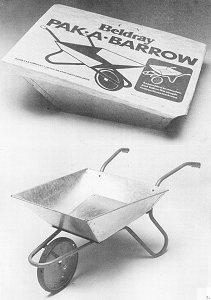 |
Amongst Beldray's galvanised goods was the Trojan wheel barrow. About the time I joined them they added this Pak-a-Barrow to the range. It was sold in the pack shown at the top, with all the bits loaded into the body. The idea was to say space for transport and storage and was aimed at the then burgeoning cash and carry DIY operations. |
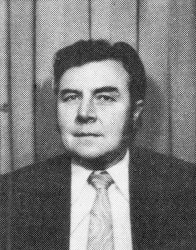 |
This is a "mug shot" of me when I joined the firm in 1976. I had started work with the Wolverhampton Gas Company, moved to Ever Ready in 1955 as a factory planning engineer but became involved with training after the passing of the Industrial Training Act 1964. I joined Norton Villiers as their Chief Training Officer in 1968 and became their Personnel Manager and Staff Controller in 1970. |
The company was bought out by Butterfield-Harvey Ltd, a
conglomerate, in about 1972. I joined Bradleys on 5th January 1976
as Personnel Manager and Staff Controller in 1976. At that time John
Barnes was the Managing Director and Anthony Corbett was the Chief
Production Engineer, having started at Bradleys just a month before
me.
On Thursday 1st December 1977 the company officially
changed its name from Bradley and Company Ltd. to Beldray Ltd.
"Beldray" was an anagram of Bradley and had been used as our
trade name since at least the turn of the century and it was the name most
people recognised.
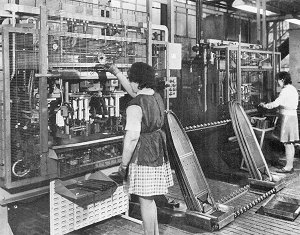 |
Enormous numbers of items were produced and new machinery was constantly being installed. Here are two multi-spot welding machines, by the British Federal Welding and Machine Co. of Dudley, which we put in to increase production rates of the famous ironing boards. |
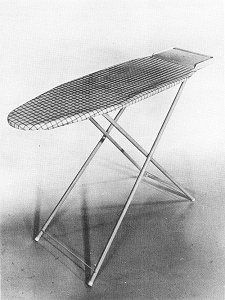 |
There was not just one ironing board but a range of them. This one, the Ideal, was the cheapest we made at the time, 1976. It had a chipboard rather than a metal top. |
| When the name changed the company re-vamped its corporate image and all the vehicles were repainted in blue and white. |
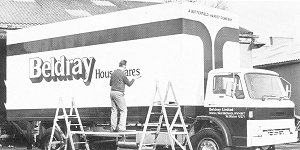 |
This is a point of salemerchandising unit deisgned by us with the makers, Lewis's, in 1979. It displays board covers, the Ironsto and, of course, the famous ironing boards. |
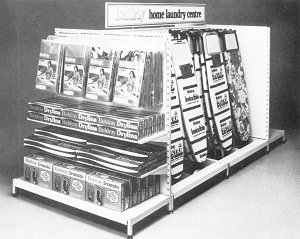 |
At the end of 1978 the company announced plans for a massive modernisation and expansion of the factory in Mount Pleasant. Some of the buildings we were then using actually dated back to the foundation of the company, the layout was inefficient, the warehouse regularly flooded in heavy rain and several old mine shafts were found under the buildings. The new buildings occupied a site of nearly five acres. We already owned some of it as it held the paint shop, garage and tool store. We had to acquire the rest of the land from the Barton Park Industrial Estate and Wolverhampton Corporation.

An artist's impression of the
new buildings
The disruption was enormous and the risk was that we
would not be able to produce sufficient to meet demand. One way we
overcame this was to work a great deal of overtime to stockpile
products. It gives some idea of our production numbers that we
planned to produce an extra 50,000 ironing boards; 20,000 Ironstos;
6,000 sleeveboards; and 4,000 wheelbarrows.
Butterfield-Harvey started selling off bits of their
organisation and sold Bradleys to Krug International, a large American
concern. They remained the ultimate owners until about 2000, when a
management buy out took place.
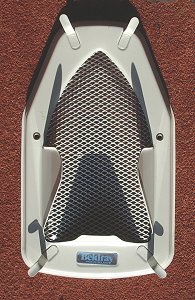 |
The Beldray "Ironsto". The idea was that you screwed this device to the wall of a cupboard, or some other storage area, and then stowed your iron on it - which you could do even when the iron was still hot. (Thanks to Vin Calcutt for locating this item). |
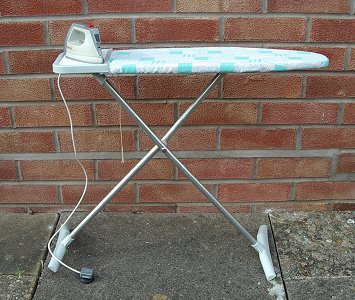 |
This is a Beldray toy ironing board. It stands about 20 inches high (about 50 cms) and it came with a toy Morphy Richards iron, complete with a lead with a suction pad to fix to the wall as if it was a plugged in to the mains. |
While I was there the company made what had become its traditional range of products - domestic products of all kinds, including the famous ironing board, of which we made vast numbers which, like many of our other products, went all over the world. The range included many galvanised products and we had our own galvanising plant. The change in the product range to mainly safely equipment took place after I left in 1994.
| A Beldray tie. The tie is very wide, almost kipper tie width. That helps to date it and shows that the staff were expected to be fashionable corporate men. (Thanks to Kath Kiely for locating this item). |
|
People often mention the Beldray ghost. I can confirm that to many people who worked there he was very real; some had seen him and a lot had sensed him. He was said to be the ghost of Herman Bradley and he lived on the top floor of the building facing Mount Pleasant. But he also wandered around the whole factory. I remember that, in about 1977, a security officer, patrolling the factory in the middle of the night, saw him emerge out of an old garage. The security officer took off and never came back to work - leaving me, as Personnel Manager, to explain to the Board of Directors that we had no security officer because he had been frightened by a ghost. I never saw the ghost myself. The building in which he lived was sold off and is now occupied by Wolverhampton City Council's social services department who would, I am sure, be able to deal with his case.
 |
| Return to the Beldray front page |